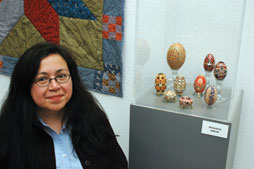By Sharon Murra-Kapon/south news editor

Art preserves cultures, and Annie Gabriel has soared out of her cultural nest to make decorative eggs.
Gabriel is an artist of Hispanic origin, but she delved into the Ukrainian culture 12 years ago when her son came home from school with a project to make pysanky eggs.
From that day on, she has learned the culture and perfected her skills making the world-famous dyed eggs.
Pysanky comes from the Ukrainian word pysaty, to write. The eggs have many symbolic writings, and their interpretation varies with each artist.
Dyed eggs are made for many uses.
A Ukrainian legend tells of a monster bound to a tree, and every time a pysanky is made, he remains in bondage.
If there is no pysanky, the monster’s bounds loosen and he will then destroy the world.
After being offered to the spirits of the tribal ancestors to obtain a blessing, dyed eggs were put on loved ones’ graves during the annual spring festival.
In addition, farmers put them on their lands for protection. In ancient times, the symbols in the eggs depicted the sun god and the stars.
When Christianity was introduced in the Ukraine, the symbols used in past rituals started to interpret the new religion as well.
For example, the eight-pointed star, then a sign of the sun god, became the image of Christ; the dots, which then represented the stars, became Mary’s tears when she asked Pilot for mercy in one of their legends.
The four-spiked solar wheel became the symbol of the cross. From then on, pysanky became the famous Easter eggs.
Something that attracted Gabriel the most to the Ukrainian culture was its matriarchal society period before Christ. Women fished, hunted and decorated their homes with eggs of many colors and designs.
“ The strength of women tends to be underestimated,” she said.
Gabriel decorates the eggs and gives them away at Easter time, going along with the ancient tradition.
Gabriel loves making them because it helps her to rest her mind. She even has a display at home for friends and family to see.
Her designs have many interpretations. Some do not relate to Easter. She uses different symbols, whether animal, plant or geometrical, to add her own meaning.
Animals resemble prosperity; trees, renewal and springtime; flowers represent beauty, elegance, feminine energy; circles, eternity.
It was not until Gabriel returned to her studies at TCC that she found the Women In New Roles program on South Campus.
She knew she could find women there who share her viewpoints.
During one of the WINR classes last year, Triesha Light, associate professor of psychology, said everyone is good at something.
As the students exposed their talents, Gabriel showed her art and soon was asked to participate in this year’s art show Women in the Globalization of the Arts in the Carillon Gallery on South Campus.
“ I was afraid to be in the exhibit because of public opinion and critique,” she said.
Nevertheless, Gabriel enjoyed this artistic experience and is looking forward to completing her degree in art at TCC.


























